Countering the ISIS/ISIL Threat
VerifiedAdded on 2023/06/05
|7
|1495
|146
AI Summary
This article discusses the threat of ISIS/ISIL and how to counter it effectively. It covers the importance of team building, information sharing, and financial pooling. The article also provides recommendations to law enforcement agencies and an annotated bibliography of relevant sources.
Contribute Materials
Your contribution can guide someone’s learning journey. Share your
documents today.
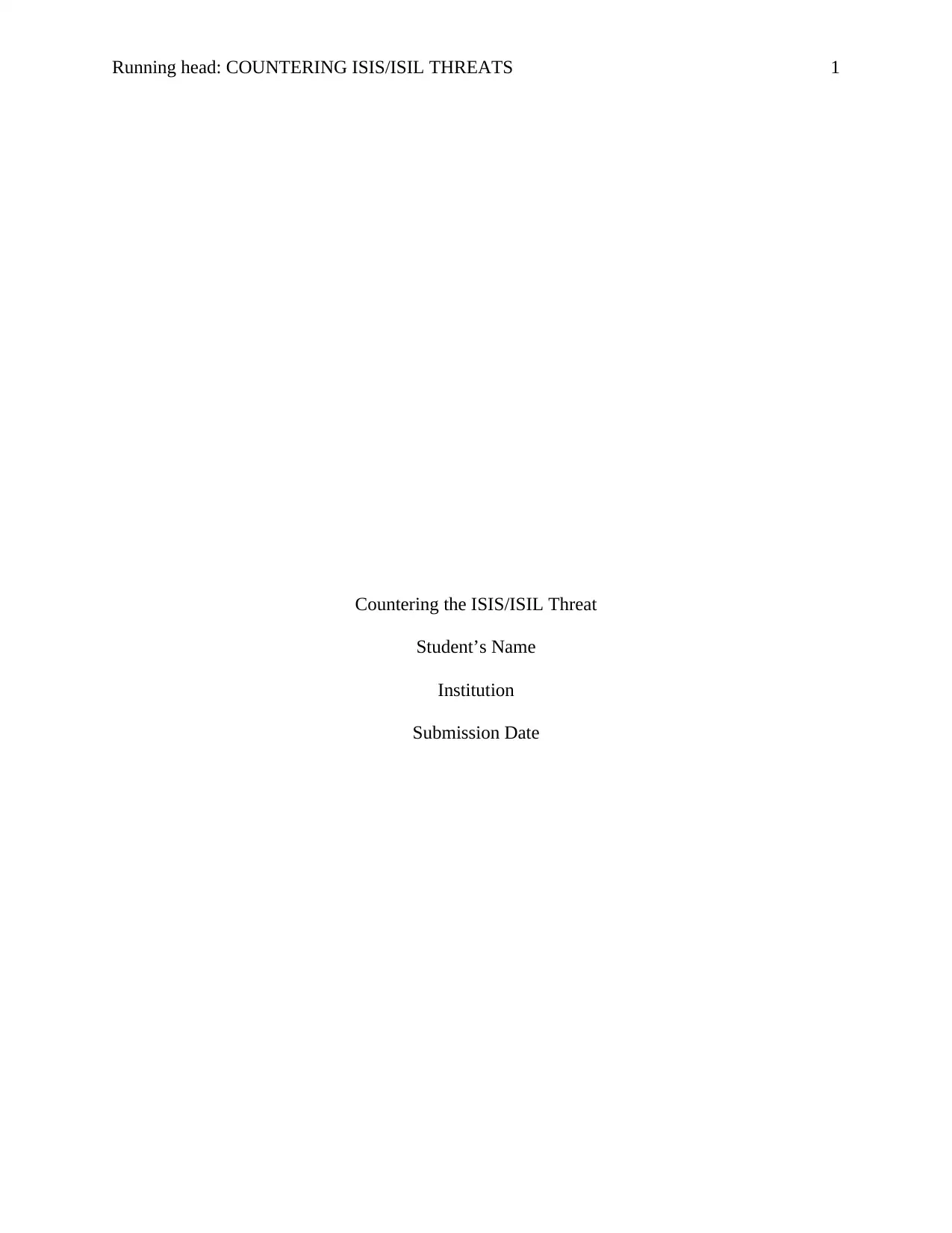
Running head: COUNTERING ISIS/ISIL THREATS 1
Countering the ISIS/ISIL Threat
Student’s Name
Institution
Submission Date
Countering the ISIS/ISIL Threat
Student’s Name
Institution
Submission Date
Secure Best Marks with AI Grader
Need help grading? Try our AI Grader for instant feedback on your assignments.
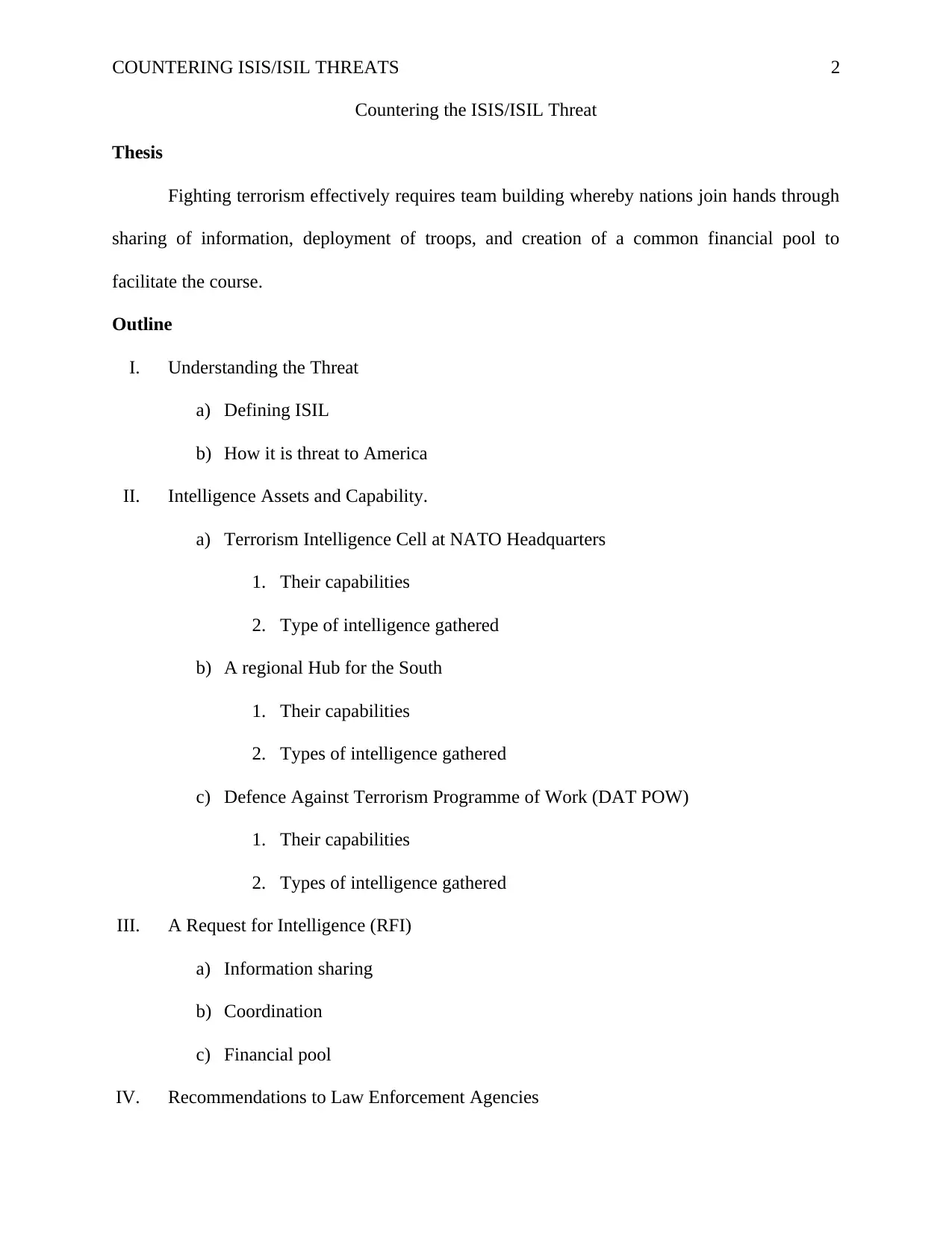
COUNTERING ISIS/ISIL THREATS 2
Countering the ISIS/ISIL Threat
Thesis
Fighting terrorism effectively requires team building whereby nations join hands through
sharing of information, deployment of troops, and creation of a common financial pool to
facilitate the course.
Outline
I. Understanding the Threat
a) Defining ISIL
b) How it is threat to America
II. Intelligence Assets and Capability.
a) Terrorism Intelligence Cell at NATO Headquarters
1. Their capabilities
2. Type of intelligence gathered
b) A regional Hub for the South
1. Their capabilities
2. Types of intelligence gathered
c) Defence Against Terrorism Programme of Work (DAT POW)
1. Their capabilities
2. Types of intelligence gathered
III. A Request for Intelligence (RFI)
a) Information sharing
b) Coordination
c) Financial pool
IV. Recommendations to Law Enforcement Agencies
Countering the ISIS/ISIL Threat
Thesis
Fighting terrorism effectively requires team building whereby nations join hands through
sharing of information, deployment of troops, and creation of a common financial pool to
facilitate the course.
Outline
I. Understanding the Threat
a) Defining ISIL
b) How it is threat to America
II. Intelligence Assets and Capability.
a) Terrorism Intelligence Cell at NATO Headquarters
1. Their capabilities
2. Type of intelligence gathered
b) A regional Hub for the South
1. Their capabilities
2. Types of intelligence gathered
c) Defence Against Terrorism Programme of Work (DAT POW)
1. Their capabilities
2. Types of intelligence gathered
III. A Request for Intelligence (RFI)
a) Information sharing
b) Coordination
c) Financial pool
IV. Recommendations to Law Enforcement Agencies
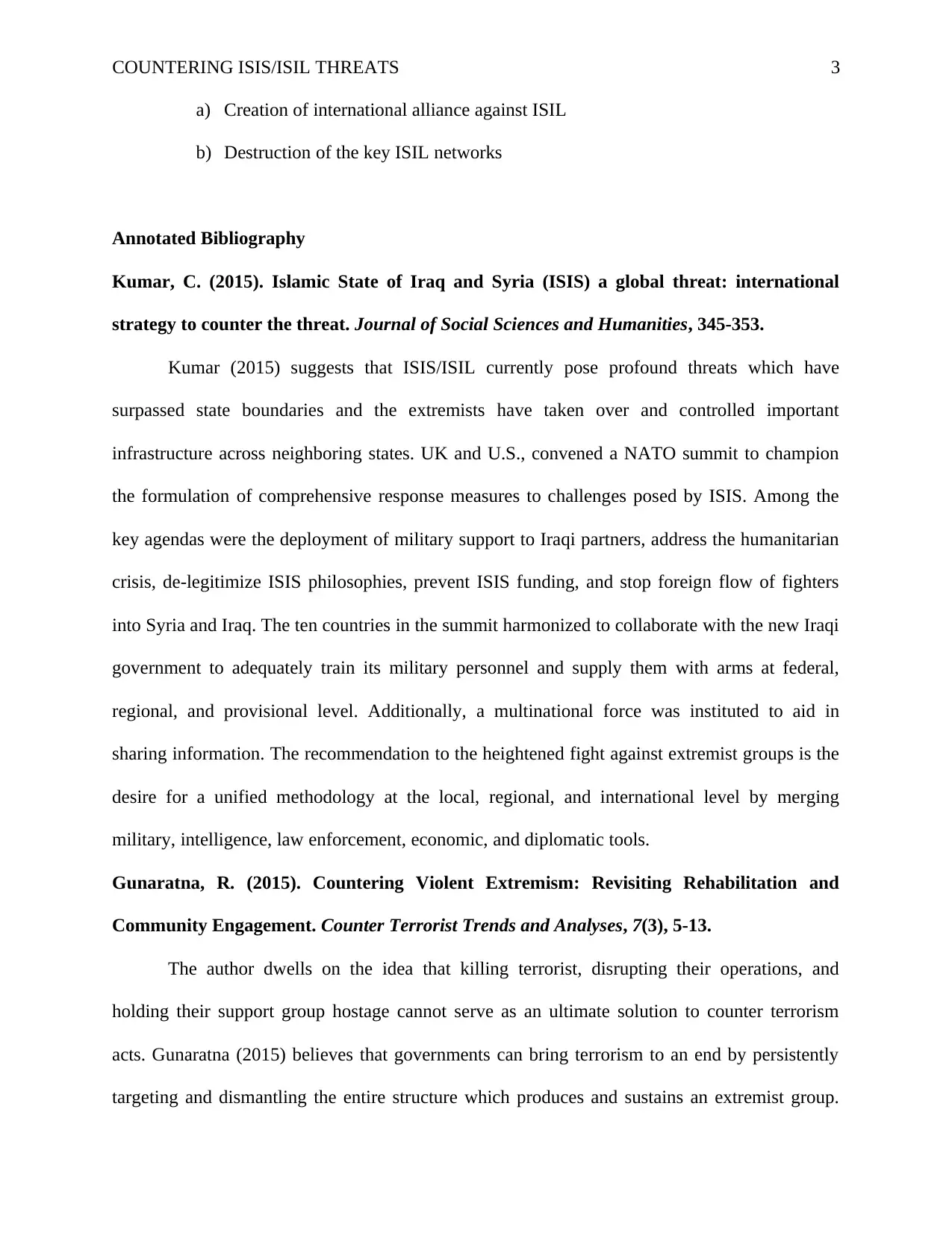
COUNTERING ISIS/ISIL THREATS 3
a) Creation of international alliance against ISIL
b) Destruction of the key ISIL networks
Annotated Bibliography
Kumar, C. (2015). Islamic State of Iraq and Syria (ISIS) a global threat: international
strategy to counter the threat. Journal of Social Sciences and Humanities, 345-353.
Kumar (2015) suggests that ISIS/ISIL currently pose profound threats which have
surpassed state boundaries and the extremists have taken over and controlled important
infrastructure across neighboring states. UK and U.S., convened a NATO summit to champion
the formulation of comprehensive response measures to challenges posed by ISIS. Among the
key agendas were the deployment of military support to Iraqi partners, address the humanitarian
crisis, de-legitimize ISIS philosophies, prevent ISIS funding, and stop foreign flow of fighters
into Syria and Iraq. The ten countries in the summit harmonized to collaborate with the new Iraqi
government to adequately train its military personnel and supply them with arms at federal,
regional, and provisional level. Additionally, a multinational force was instituted to aid in
sharing information. The recommendation to the heightened fight against extremist groups is the
desire for a unified methodology at the local, regional, and international level by merging
military, intelligence, law enforcement, economic, and diplomatic tools.
Gunaratna, R. (2015). Countering Violent Extremism: Revisiting Rehabilitation and
Community Engagement. Counter Terrorist Trends and Analyses, 7(3), 5-13.
The author dwells on the idea that killing terrorist, disrupting their operations, and
holding their support group hostage cannot serve as an ultimate solution to counter terrorism
acts. Gunaratna (2015) believes that governments can bring terrorism to an end by persistently
targeting and dismantling the entire structure which produces and sustains an extremist group.
a) Creation of international alliance against ISIL
b) Destruction of the key ISIL networks
Annotated Bibliography
Kumar, C. (2015). Islamic State of Iraq and Syria (ISIS) a global threat: international
strategy to counter the threat. Journal of Social Sciences and Humanities, 345-353.
Kumar (2015) suggests that ISIS/ISIL currently pose profound threats which have
surpassed state boundaries and the extremists have taken over and controlled important
infrastructure across neighboring states. UK and U.S., convened a NATO summit to champion
the formulation of comprehensive response measures to challenges posed by ISIS. Among the
key agendas were the deployment of military support to Iraqi partners, address the humanitarian
crisis, de-legitimize ISIS philosophies, prevent ISIS funding, and stop foreign flow of fighters
into Syria and Iraq. The ten countries in the summit harmonized to collaborate with the new Iraqi
government to adequately train its military personnel and supply them with arms at federal,
regional, and provisional level. Additionally, a multinational force was instituted to aid in
sharing information. The recommendation to the heightened fight against extremist groups is the
desire for a unified methodology at the local, regional, and international level by merging
military, intelligence, law enforcement, economic, and diplomatic tools.
Gunaratna, R. (2015). Countering Violent Extremism: Revisiting Rehabilitation and
Community Engagement. Counter Terrorist Trends and Analyses, 7(3), 5-13.
The author dwells on the idea that killing terrorist, disrupting their operations, and
holding their support group hostage cannot serve as an ultimate solution to counter terrorism
acts. Gunaratna (2015) believes that governments can bring terrorism to an end by persistently
targeting and dismantling the entire structure which produces and sustains an extremist group.
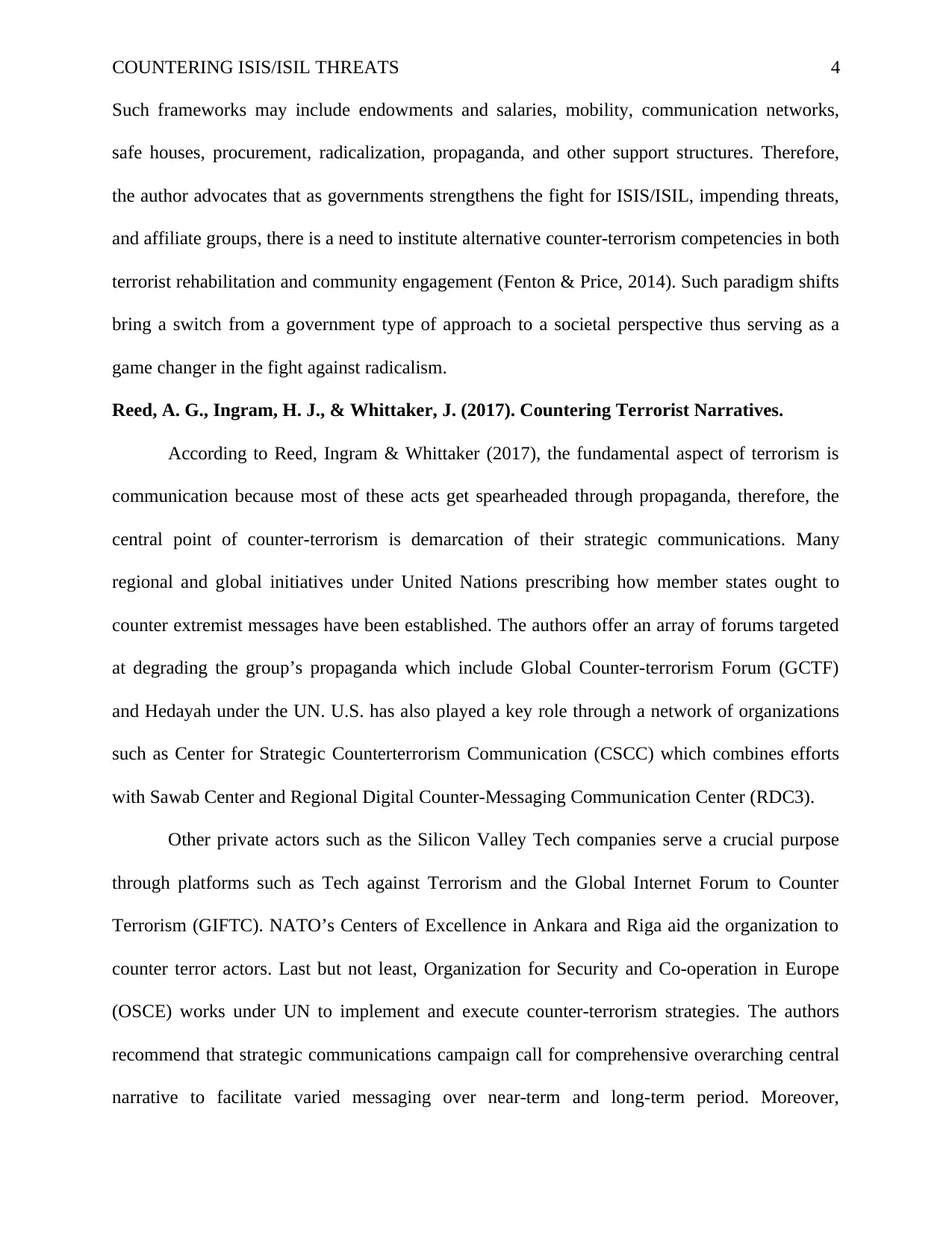
COUNTERING ISIS/ISIL THREATS 4
Such frameworks may include endowments and salaries, mobility, communication networks,
safe houses, procurement, radicalization, propaganda, and other support structures. Therefore,
the author advocates that as governments strengthens the fight for ISIS/ISIL, impending threats,
and affiliate groups, there is a need to institute alternative counter-terrorism competencies in both
terrorist rehabilitation and community engagement (Fenton & Price, 2014). Such paradigm shifts
bring a switch from a government type of approach to a societal perspective thus serving as a
game changer in the fight against radicalism.
Reed, A. G., Ingram, H. J., & Whittaker, J. (2017). Countering Terrorist Narratives.
According to Reed, Ingram & Whittaker (2017), the fundamental aspect of terrorism is
communication because most of these acts get spearheaded through propaganda, therefore, the
central point of counter-terrorism is demarcation of their strategic communications. Many
regional and global initiatives under United Nations prescribing how member states ought to
counter extremist messages have been established. The authors offer an array of forums targeted
at degrading the group’s propaganda which include Global Counter-terrorism Forum (GCTF)
and Hedayah under the UN. U.S. has also played a key role through a network of organizations
such as Center for Strategic Counterterrorism Communication (CSCC) which combines efforts
with Sawab Center and Regional Digital Counter-Messaging Communication Center (RDC3).
Other private actors such as the Silicon Valley Tech companies serve a crucial purpose
through platforms such as Tech against Terrorism and the Global Internet Forum to Counter
Terrorism (GIFTC). NATO’s Centers of Excellence in Ankara and Riga aid the organization to
counter terror actors. Last but not least, Organization for Security and Co-operation in Europe
(OSCE) works under UN to implement and execute counter-terrorism strategies. The authors
recommend that strategic communications campaign call for comprehensive overarching central
narrative to facilitate varied messaging over near-term and long-term period. Moreover,
Such frameworks may include endowments and salaries, mobility, communication networks,
safe houses, procurement, radicalization, propaganda, and other support structures. Therefore,
the author advocates that as governments strengthens the fight for ISIS/ISIL, impending threats,
and affiliate groups, there is a need to institute alternative counter-terrorism competencies in both
terrorist rehabilitation and community engagement (Fenton & Price, 2014). Such paradigm shifts
bring a switch from a government type of approach to a societal perspective thus serving as a
game changer in the fight against radicalism.
Reed, A. G., Ingram, H. J., & Whittaker, J. (2017). Countering Terrorist Narratives.
According to Reed, Ingram & Whittaker (2017), the fundamental aspect of terrorism is
communication because most of these acts get spearheaded through propaganda, therefore, the
central point of counter-terrorism is demarcation of their strategic communications. Many
regional and global initiatives under United Nations prescribing how member states ought to
counter extremist messages have been established. The authors offer an array of forums targeted
at degrading the group’s propaganda which include Global Counter-terrorism Forum (GCTF)
and Hedayah under the UN. U.S. has also played a key role through a network of organizations
such as Center for Strategic Counterterrorism Communication (CSCC) which combines efforts
with Sawab Center and Regional Digital Counter-Messaging Communication Center (RDC3).
Other private actors such as the Silicon Valley Tech companies serve a crucial purpose
through platforms such as Tech against Terrorism and the Global Internet Forum to Counter
Terrorism (GIFTC). NATO’s Centers of Excellence in Ankara and Riga aid the organization to
counter terror actors. Last but not least, Organization for Security and Co-operation in Europe
(OSCE) works under UN to implement and execute counter-terrorism strategies. The authors
recommend that strategic communications campaign call for comprehensive overarching central
narrative to facilitate varied messaging over near-term and long-term period. Moreover,
Paraphrase This Document
Need a fresh take? Get an instant paraphrase of this document with our AI Paraphraser

COUNTERING ISIS/ISIL THREATS 5
disruption of violent extremist links should also be all-inclusive and multi-faceted to avoid
displacement.
Fernandez, A. M. (2015). Here to stay and growing: Combating ISIS propaganda
networks. Washington DC (Estados Unidos): The Brookings Project on US Relations with the
Islamic World.
The article analyzes ISIS’s propaganda with the aim of determining the reasons behind
the recent failures in counter-messaging efforts and how the issue can be resolved to meet future
ideologies in countering ISIS/ISIL threats. It gives historical outline of al-Qaeda and ISIS
propaganda and how Jihadist propaganda has evolved over the years. Fernandez (2015)
elaborates that ISIS often consider social media as their vocal point in enlisting new members to
its ranks. He identifies key themes which serve as the ISIS brands of propaganda and goes
further to expound why ISIS messaging is unique. He offers insight on the various approaches
that have been employed by various regional and international actors in counter-terrorism and
why they have proved ineffective. He recommends on creation of sizeable and authentic online
communities of interest, advocates for production of more content, and enhancement of rigorous
social media policing practices by both private and government actors.
Spalek, B. (2014). Community Engagement for Counterterrorism in Britain: An
Exploration of the Role of “Connectors” in Countering Takfiri Jihadist Terrorism. Studies
in Conflict & Terrorism, 37(10), 825–841. https://doi.org/10.1080/1057610X.2014.941436
Spalek (2014) specifically focused on the contribution by the community in fighting
terrorism. The author argued that there has been poor community initiative since the current
initiatives entails an all-encompassing claim that put in task all community members. According
to the author, such approach is not effective. The author highlights the idea that rather than
engaging Muslim communities in the process, it would be better to rely on key individuals who
disruption of violent extremist links should also be all-inclusive and multi-faceted to avoid
displacement.
Fernandez, A. M. (2015). Here to stay and growing: Combating ISIS propaganda
networks. Washington DC (Estados Unidos): The Brookings Project on US Relations with the
Islamic World.
The article analyzes ISIS’s propaganda with the aim of determining the reasons behind
the recent failures in counter-messaging efforts and how the issue can be resolved to meet future
ideologies in countering ISIS/ISIL threats. It gives historical outline of al-Qaeda and ISIS
propaganda and how Jihadist propaganda has evolved over the years. Fernandez (2015)
elaborates that ISIS often consider social media as their vocal point in enlisting new members to
its ranks. He identifies key themes which serve as the ISIS brands of propaganda and goes
further to expound why ISIS messaging is unique. He offers insight on the various approaches
that have been employed by various regional and international actors in counter-terrorism and
why they have proved ineffective. He recommends on creation of sizeable and authentic online
communities of interest, advocates for production of more content, and enhancement of rigorous
social media policing practices by both private and government actors.
Spalek, B. (2014). Community Engagement for Counterterrorism in Britain: An
Exploration of the Role of “Connectors” in Countering Takfiri Jihadist Terrorism. Studies
in Conflict & Terrorism, 37(10), 825–841. https://doi.org/10.1080/1057610X.2014.941436
Spalek (2014) specifically focused on the contribution by the community in fighting
terrorism. The author argued that there has been poor community initiative since the current
initiatives entails an all-encompassing claim that put in task all community members. According
to the author, such approach is not effective. The author highlights the idea that rather than
engaging Muslim communities in the process, it would be better to rely on key individuals who
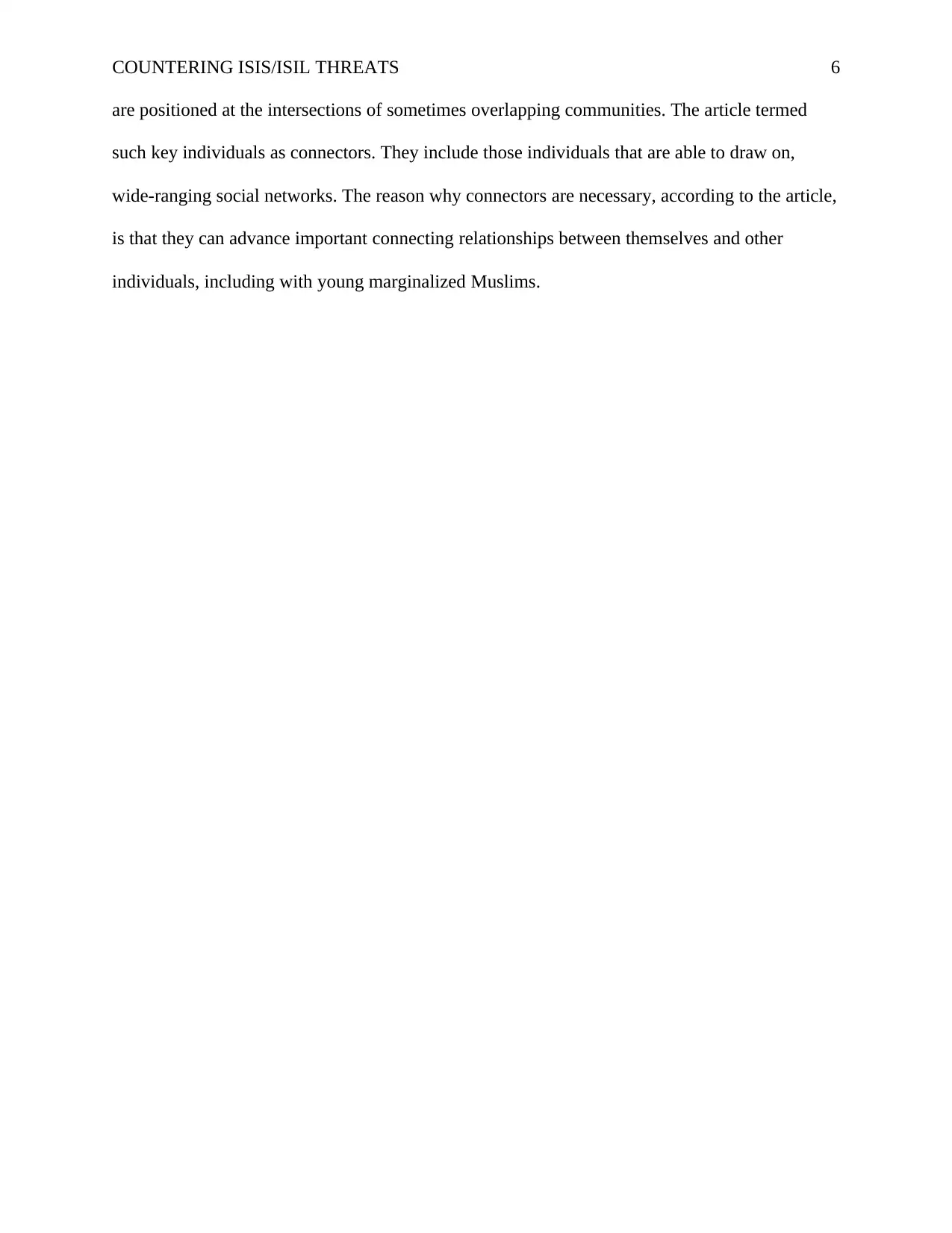
COUNTERING ISIS/ISIL THREATS 6
are positioned at the intersections of sometimes overlapping communities. The article termed
such key individuals as connectors. They include those individuals that are able to draw on,
wide-ranging social networks. The reason why connectors are necessary, according to the article,
is that they can advance important connecting relationships between themselves and other
individuals, including with young marginalized Muslims.
are positioned at the intersections of sometimes overlapping communities. The article termed
such key individuals as connectors. They include those individuals that are able to draw on,
wide-ranging social networks. The reason why connectors are necessary, according to the article,
is that they can advance important connecting relationships between themselves and other
individuals, including with young marginalized Muslims.

COUNTERING ISIS/ISIL THREATS 7
References
Fenton, A., & Price, D. (2014). Forbidden Funds -- Indonesia’s New Legislation for Countering
the Financing of Terrorism. Australian Journal of Asian Law, 15(1), 1–19. Retrieved
from http://search.ebscohost.com/login.aspx?
direct=true&db=a9h&AN=102808486&site=ehost-live
Fernandez, A. M. (2015). Here to stay and growing: Combating ISIS propaganda
networks. Washington DC (Estados Unidos): The Brookings Project on US Relations
with the Islamic World.
Gunaratna, R. (2015). Countering Violent Extremism: Revisiting Rehabilitation and Community
Engagement. Counter Terrorist Trends and Analyses, 7(3), 5-13.
Kumar, C. (2015). Islamic State of Iraq and Syria (ISIS) a global threat: international strategy to
counter the threat. Journal of Social Sciences and Humanities, 345-353.
Reed, A. G., Ingram, H. J., & Whittaker, J. (2017). Countering Terrorist Narratives.
Spalek, B. (2014). Community Engagement for Counterterrorism in Britain: An Exploration of
the Role of “Connectors” in Countering Takfiri Jihadist Terrorism. Studies in Conflict &
Terrorism, 37(10), 825–841. https://doi.org/10.1080/1057610X.2014.941436
References
Fenton, A., & Price, D. (2014). Forbidden Funds -- Indonesia’s New Legislation for Countering
the Financing of Terrorism. Australian Journal of Asian Law, 15(1), 1–19. Retrieved
from http://search.ebscohost.com/login.aspx?
direct=true&db=a9h&AN=102808486&site=ehost-live
Fernandez, A. M. (2015). Here to stay and growing: Combating ISIS propaganda
networks. Washington DC (Estados Unidos): The Brookings Project on US Relations
with the Islamic World.
Gunaratna, R. (2015). Countering Violent Extremism: Revisiting Rehabilitation and Community
Engagement. Counter Terrorist Trends and Analyses, 7(3), 5-13.
Kumar, C. (2015). Islamic State of Iraq and Syria (ISIS) a global threat: international strategy to
counter the threat. Journal of Social Sciences and Humanities, 345-353.
Reed, A. G., Ingram, H. J., & Whittaker, J. (2017). Countering Terrorist Narratives.
Spalek, B. (2014). Community Engagement for Counterterrorism in Britain: An Exploration of
the Role of “Connectors” in Countering Takfiri Jihadist Terrorism. Studies in Conflict &
Terrorism, 37(10), 825–841. https://doi.org/10.1080/1057610X.2014.941436
1 out of 7
Your All-in-One AI-Powered Toolkit for Academic Success.
+13062052269
info@desklib.com
Available 24*7 on WhatsApp / Email
![[object Object]](/_next/static/media/star-bottom.7253800d.svg)
Unlock your academic potential
© 2024 | Zucol Services PVT LTD | All rights reserved.

